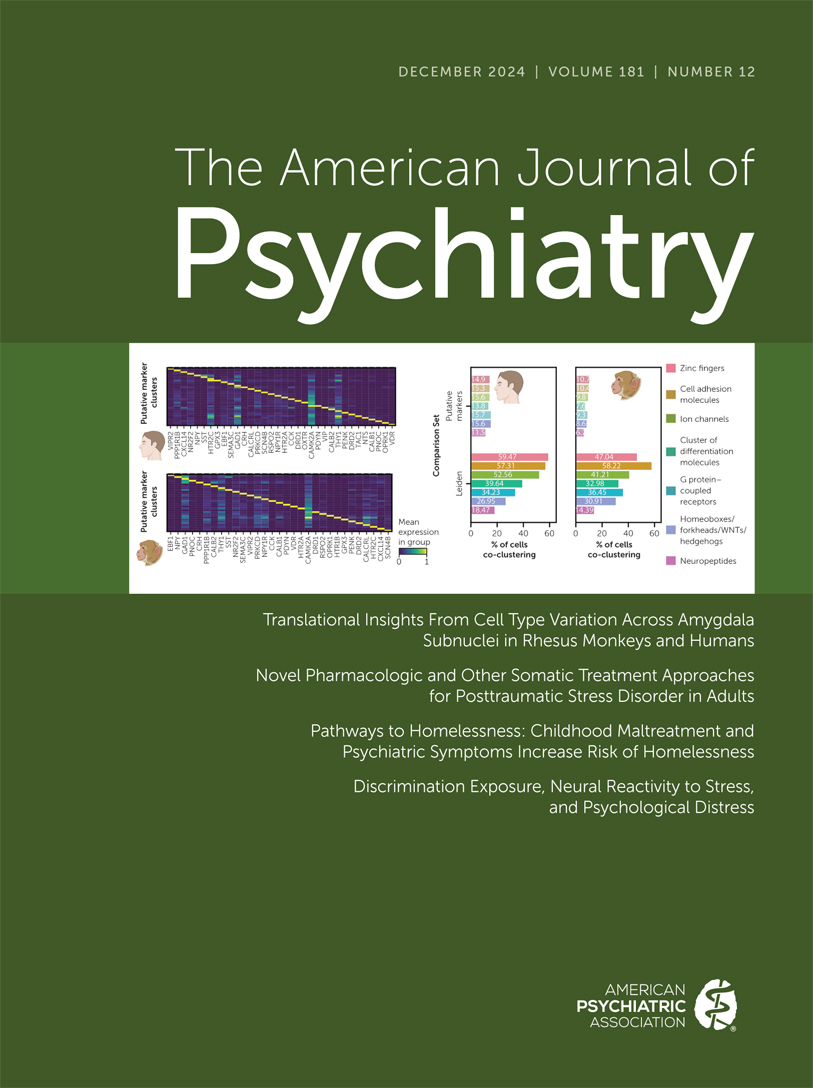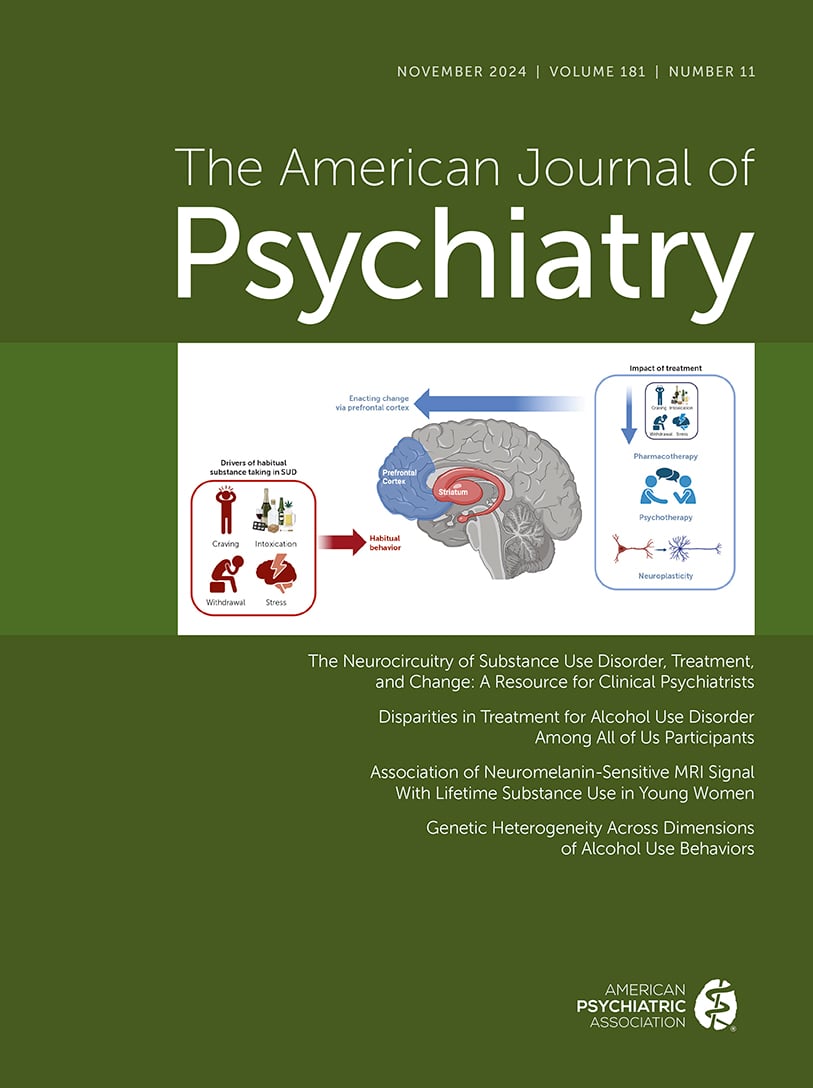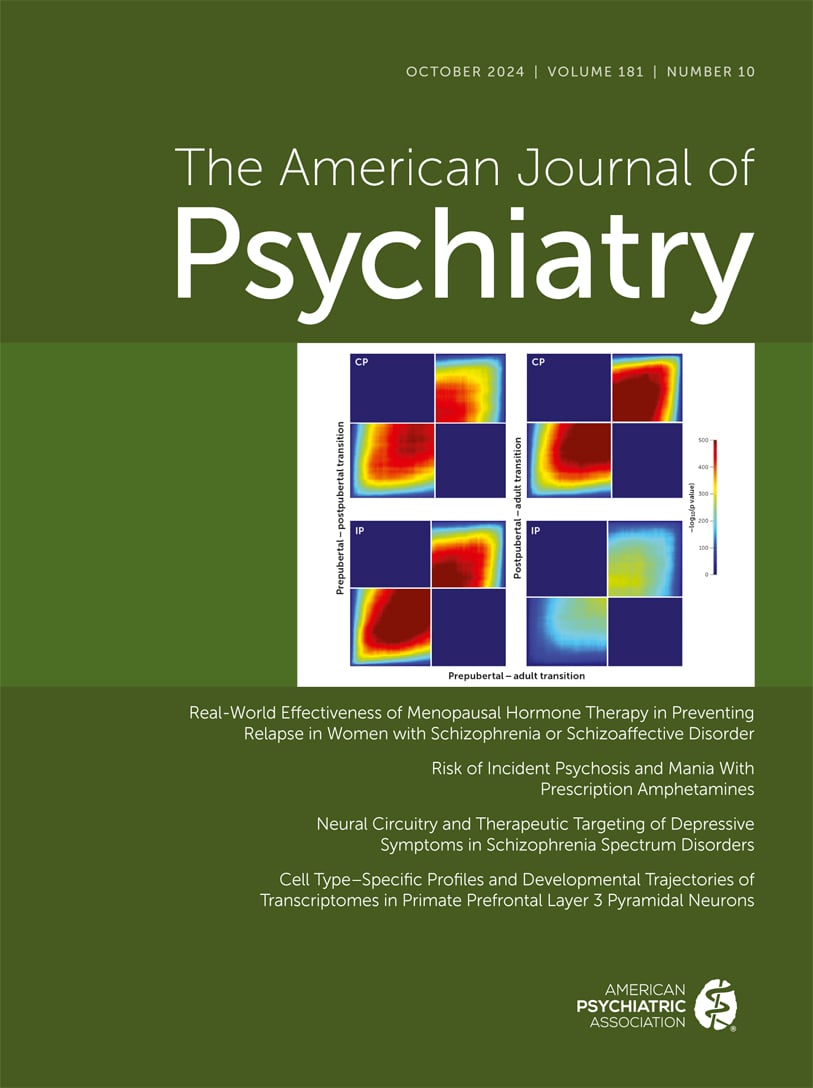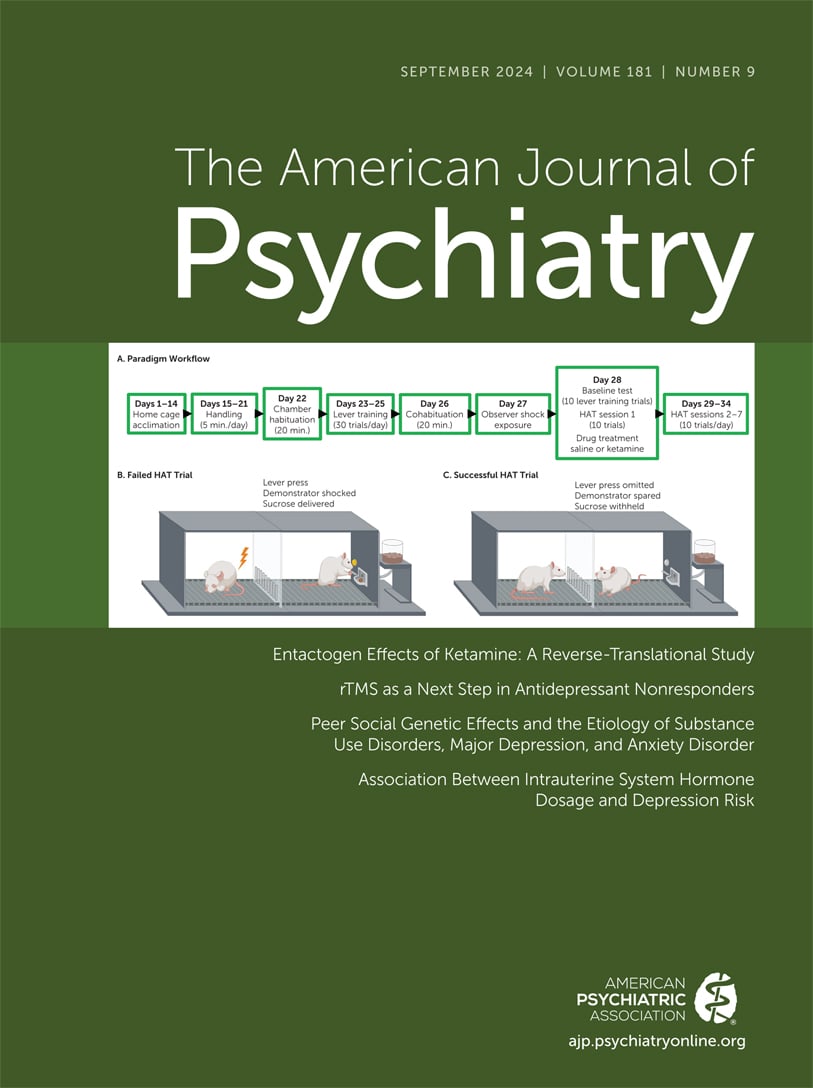American Journal of Psychiatry
- Volume 161
- Number 7
- July 2004
In This Issue
Editorial
Reviews and Overviews
Publication date: 01 July 2004
Pages1149–1158OBJECTIVE: The purpose of this article is to further an understanding of the psychological state when aggression follows an episode of partial arousal from early non-REM sleep during which some areas of the brain appear to be functioning as in waking ...
https://doi.org/10.1176/appi.ajp.161.7.1149Publication date: 01 July 2004
Pages1159–1168OBJECTIVE: Psychiatric clinical studies, including those in drug abuse research, often provide data that are challenging to analyze and use for hypothesis testing because they are heavily skewed and marked by an abundance of zero values. The authors ...
https://doi.org/10.1176/appi.ajp.161.7.1159Images in Neuroscience
Introspections
Images in Psychiatry
Article
Publication date: 01 July 2004
Pages1173–1180OBJECTIVE: Methylphenidate is the most commonly prescribed drug for attention deficit hyperactivity disorder (ADHD), yet its therapeutic mechanisms are poorly understood. The objective of this study was to assess if methylphenidate, by increasing dopamine ...
https://doi.org/10.1176/appi.ajp.161.7.1173Publication date: 01 July 2004
Pages1181–1189OBJECTIVE: Recent functional imaging studies have reported evidence of alterations in the serotonergic system induced by 3,4-methylenedioxymethamphetamine (MDMA), or “Ecstasy.” However, these studies have often been limited by small sample size, lack of ...
https://doi.org/10.1176/appi.ajp.161.7.1181Publication date: 01 July 2004
Pages1190–1196OBJECTIVE: The authors asked if hematological indices of RBC status and hepatic function in newly sober alcoholic men are related to abnormalities in brain morphology, change with normalization of brain function during short-term sobriety, and predict ...
https://doi.org/10.1176/appi.ajp.161.7.1190Publication date: 01 July 2004
Pages1197–1203OBJECTIVE: Using prospective data, the authors assessed the risk of alcohol-related problems among individuals with self-reported sleep disturbances because of worry. METHOD: As part of the Epidemiologic Catchment Area program, a probability sample of ...
https://doi.org/10.1176/appi.ajp.161.7.1197Publication date: 01 July 2004
Pages1204–1210OBJECTIVE: This study was conducted to describe the order of appearance and the progression of alcohol-related life events in Mission Indian men and women with a lifetime diagnosis of alcohol dependence. METHOD: A total of 407 participants completed a ...
https://doi.org/10.1176/appi.ajp.161.7.1204Publication date: 01 July 2004
Pages1211–1218OBJECTIVE: Substantial evidence from animal models demonstrates that dopamine release in the ventral striatum underlies the reinforcing properties of nicotine. The authors used [11C]raclopride bolus-plus-continuous-infusion positron emission tomography (...
https://doi.org/10.1176/appi.ajp.161.7.1211Publication date: 01 July 2004
Pages1219–1223OBJECTIVE: The prevalence of cigarette smoking among schizophrenia patients is significantly higher than in the general population; this may reflect self-medication of symptoms and/or adverse effects of neuroleptics. The authors examined the prevalence of ...
https://doi.org/10.1176/appi.ajp.161.7.1219Publication date: 01 July 2004
Pages1224–1230OBJECTIVE: The goal of the present study was to identify specific genetic associations with smoking progression in adolescents and to determine whether these genetic effects on smoking practices are potentiated by depression symptoms. METHOD: Effects of ...
https://doi.org/10.1176/appi.ajp.161.7.1224Publication date: 01 July 2004
Pages1231–1237OBJECTIVE: The authors’ goal was to assess the validity of DSM-IV diagnoses obtained with the Spanish versions of the Psychiatric Research Interview for Substance and Mental Disorders (PRISM) and the Structured Clinical Interview for DSM-IV (SCID) ...
https://doi.org/10.1176/appi.ajp.161.7.1231Publication date: 01 July 2004
Pages1238–1246OBJECTIVE: The authors sought to identify neural correlates of eating disorders in order to contribute to the debate on the genesis and classification of eating disorders and provide endophenotypes for genetic research. METHOD: Twenty-six female patients ...
https://doi.org/10.1176/appi.ajp.161.7.1238Publication date: 01 July 2004
Pages1247–1255OBJECTIVE: Behavioral and social impairments have been frequently reported after damage to the prefrontal cortex in humans. This study evaluated social perception in patients with prefrontal cortex lesions and compared their performance on a social ...
https://doi.org/10.1176/appi.ajp.161.7.1247Publication date: 01 July 2004
Pages1256–1263OBJECTIVE: Antidepressants that inhibit the reuptake of serotonin (SSRIs) or norepinephrine (SNRIs) are effective in the treatment of disorders such as depression and anxiety. Cognitive psychological theories emphasize the importance of correcting ...
https://doi.org/10.1176/appi.ajp.161.7.1256Publication date: 01 July 2004
Pages1264–1269OBJECTIVE: This study examined the extent to which individuals with a lifetime diagnosis of recurrent unipolar disorder endorse experiencing manic/hypomanic symptoms over their lifetimes and compared their reports with those of patients with bipolar I ...
https://doi.org/10.1176/appi.ajp.161.7.1264Publication date: 01 July 2004
Pages1270–1277OBJECTIVE: The mediodorsal and anteroventral/anteromedial nuclei of the thalamus are brain regions of interest in the study of mood disorders because they connect subcortical limbic system structures such as the amygdala with the prefrontal, cingulate, ...
https://doi.org/10.1176/appi.ajp.161.7.1270Publication date: 01 July 2004
Pages1278–1284OBJECTIVE: A controversy regarding pediatric bipolar disorder is whether to use child in addition to parent informants. To investigate this issue, the authors conducted a study comparing separate child and parent interview data for child bipolar disorder. ...
https://doi.org/10.1176/appi.ajp.161.7.1278Publication date: 01 July 2004
Pages1285–1289OBJECTIVE: There is little empirical evidence to guide clinicians in choosing among the diverse array of antidepressants available. In the absence of replicated empirical research guiding the selection of antidepressants, it is of interest to examine what ...
https://doi.org/10.1176/appi.ajp.161.7.1285Brief Report
Publication date: 01 July 2004
Pages1290–1292OBJECTIVE: The authors attempted to reduce the rate of postpartum depression in high-risk women and to increase the time to recurrence. METHOD: Nondepressed pregnant women with at least one past episode of postpartum major depression were recruited into a ...
https://doi.org/10.1176/appi.ajp.161.7.1290Publication date: 01 July 2004
Pages1293–1296OBJECTIVE: The purpose of this study was to determine whether microstructural abnormalities in the white matter of the dorsolateral prefrontal cortex are associated with late-life depression. METHOD: Seventeen elderly depressed subjects were compared with ...
https://doi.org/10.1176/appi.ajp.161.7.1293Publication date: 01 July 2004
Pages1296–1298OBJECTIVE: The authors prospectively examined associations between each DSM-IV borderline personality disorder criterion and suicidal behaviors. METHOD: Borderline personality disorder diagnosis and criteria, major depressive disorder, substance use ...
https://doi.org/10.1176/appi.ajp.161.7.1296Publication date: 01 July 2004
Pages1299–1301OBJECTIVE: The authors examined the capacity of alexithymia to predict a broad range of psychiatric symptoms relative to that of other personality dimensions, age, and gender. METHOD: The Toronto Alexithymia Scale, the Temperament and Character Inventory, ...
https://doi.org/10.1176/appi.ajp.161.7.1299Publication date: 01 July 2004
Pages1301–1304OBJECTIVE: The influence of patient and physician variables on antipsychotic drug choice for patients with schizophrenia was assessed. METHOD: Interviews with 100 psychiatrists on drug choice for 200 patients suffering from schizophrenia were conducted. ...
https://doi.org/10.1176/appi.ajp.161.7.1301Publication date: 01 July 2004
Pages1304–1306OBJECTIVE: This study used 31-phosphorus magnetic resonance spectroscopy (31P MRS) to investigate basal ganglia abnormalities in neuroleptic-naive patients with schizophrenia. METHOD: Nineteen schizophrenia patients and 31 age- and sex-matched healthy ...
https://doi.org/10.1176/appi.ajp.161.7.1304Letter to the Editor
Book Forum: Psyche and Brain
Book Forum: Case Histories
Book Forum: Neuropsychiatry
Book Forum: Therapies for Psychosis
Book Forum: Diagnosis and Management of Specific Disorders
Correction
Past Issues
View Issues Archive
Vol. 181 | No. 12

Vol. 181 | No. 11

Vol. 181 | No. 10
